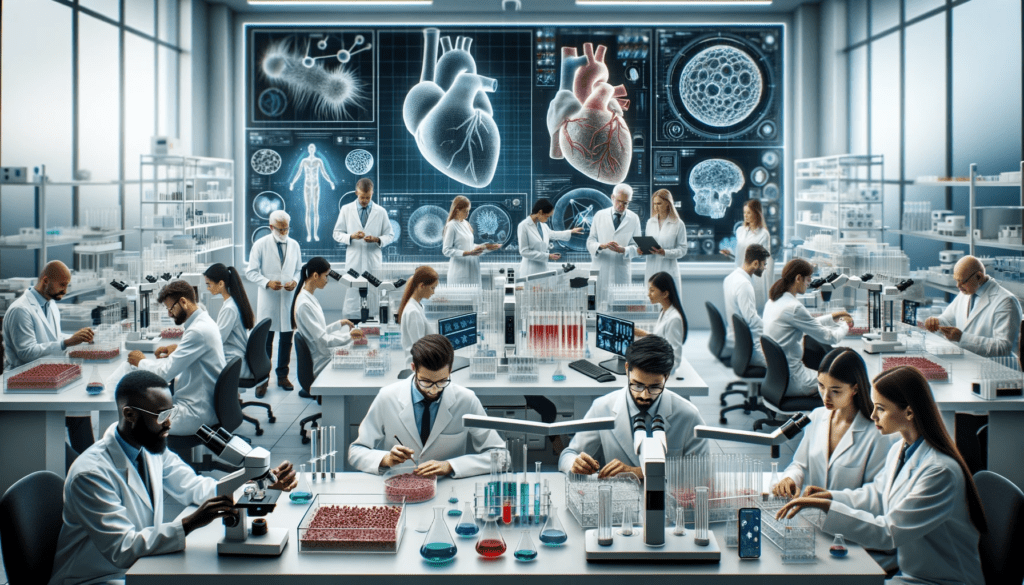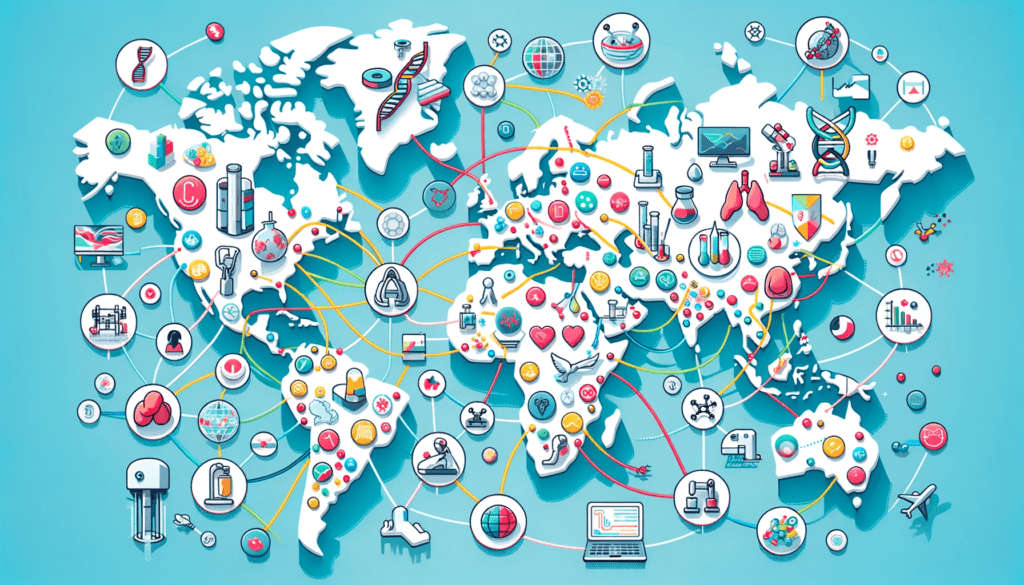The Genesis of Bioengineering for Organ Transplants
The advent of bioengineering for organ transplants can be traced back to groundbreaking experiments carried out in the mid-twentieth century. Back then, researchers took the first tentative steps in the field by exploring the possibility of artificially replicating organ functions using mechanical devices. However, these early efforts were largely rudimentary and often unsuccessful due to lack of advanced technology and deep understanding of organ biology. But these efforts were not in vain, they in fact paved the way for future developments and research in bioengineered organs.
In the early years, bioengineered organs were more an object of science fiction rather than of science. But rapid technological advancements, dedicated research, and the pioneering work of several notable scientists, dramatically changed this narrative. By the late 1980s, the bioengineering field had greatly evolved, leading to significant progress in the development of bioengineered organs. Life-saving protocols were established and organ transplants became relatively safe and predictable procedures. The tale of bioengineered organs is not just a story of scientific milestones, it is also about crushing obstacles and relentless pursuit, providing a beacon of hope for mankind.

3D Printing of Organs: A Glimpse into the Future
The technological marvel of 3D printed organs is one element in a revolutionary shift towards the use of bioengineered organs in transplantation. The potential of this technology is tremendous, and it offers a promising solution to the crippling organ shortage crisis that has plagued the medical world for years. The concept of creating functional, living organs from patients’ own cells greatly reduces the risk of organ rejection, since the organ is essentially a genetic match. This opens new doors for patients for whom a perfect donor match cannot be found, significantly broadening the patient base that can benefit from transplants.
In addition, the utilization of 3D printed organs also ushers in new possibilities in the vast field of medical research. The ability to generate bioengineered organs on demand facilitates in-depth studies of various disease models in a controlled environment, possibly accelerating breakthroughs in understanding complex diseases. Researchers can study these organs in real-time, gaining a better understanding of the pathophysiology of diseases, thereby potentially informing future treatment strategies. Thus, the advent of 3D printing technology stands as a beacon of hope, not just for organ recipients, but for the broader scientific community as well.
Genetic Engineering: Bridging the Gap Between Species
The realm of genetic engineering holds immense potential for the advancement of bioengineered organs, thereby bringing about a paradigm shift in organ transplantation. By manipulating the genetic structure of organs, scientists can create organs that are more suitable for transplantation, significantly reducing the likelihood of organ rejection. The incorporation of genetic engineering in bioengineering helps in bridging the gap between species and radically modifying the future of organ transplantation. This engineering technique not only propels the creation and accessibility of organs for transplantation, but also has the capacity to mold and alter the characteristics of bioengineered organs, rendering them more compatible and functional in the human body.
| Bioengineered Organ | Stage of Development | Potential Benefits | Challenges |
|---|---|---|---|
| 3D Printed Heart | Research | Address organ shortages, reduced wait times for transplants | Material biocompatibility, structural complexity |
| 3D Printed Kidney | Research | Address organ shortages, personalized treatment | Cellular complexity, vascularization |
| 3D Printed Liver | Research | Address organ shortages, drug testing | Cellular complexity, vascularization |
| 3D Printed Skin | Advanced Research | Improved grafts for burn victims, reduced scarring | Integration with existing vascular systems |
| 3D Printed Ear | Clinical Application | Treatment of congenital conditions, injury recovery | Material biocompatibility, aesthetic matching |
Across the globe, research teams are investing their resources in refining the functionality of bioengineered organs through genetic engineering to ultimately improve the success rate of organ transplantation. A breakthrough in this sector could potentially solve the global organ shortage crisis, thus saving countless lives. The prospects of revolutionizing organ transplantation through genetic engineering in bioengineered organs also address the economic outlook of healthcare. The future of organ transplantation lies in the successful bridging of the gap between different species, thus bringing formidable changes in medical science.
The Ethical Landscape
Genetic engineering plays a central part in creating bioengineered organs, holding the potential to do away with the traditional organ waiting list. Its capacity to modify or introduce genes into the human body can pave the way for custom-made bioengineered organs that perfectly match each patient's genetic makeup. These organs, developed specifically for each individual, can significantly reduce organ rejection chances which is a major concern in organ transplants.
Despite its promise, genetic engineering is not free from ethical concerns when it is used for bioengineered organs. It is a complex field that intertwines with matters of identity, societal norms, and the very nature of what it signifies to be human. Manipulating genetic codes, essentially the blueprint of a person, raises profound questions about autonomy, fairness, and the potential misuse of technology.
Furthermore, cost considerations also play a substantial part in the ethical landscape of bioengineered organs - while they hold the potential to save countless lives, their development and implementation are not cheap, and the question of who gets priority access to these lifesaving interventions, is another contentious ethical issue. These considerations form part of a wider discussion around the equitable distribution of healthcare resources.

The Road Ahead
As we traverse the uncharted territory of the future, the bright spark in the field of bioengineered organs promises a new era in medical transplantation. Technological advancements are steering us towards solutions that were unthinkable just decades ago. Xenotransplantation, once the subject of science fiction, is now nearing reality, signaling a potential to significantly mitigate the global organ shortage crisis. This revolutionary technique, which involves the transplantation of organs from one species to another, primarily from pigs to humans, promises to reshape our understanding of organ transplantation.
Yet, the road to widespread realization of this feat is lined with continuous research, innovation, and carefully executed experiments. The upcoming innovations in bioengineered organs promise to stretch the boundaries of what can be achieved, transforming the landscape of organ transplants as we know it. As we inch closer to fully harnessing the benefits of bioengineering, we must also continue to navigate the ethical, regulatory, and economic dynamics governing our quest for these life-saving solutions. At the heart of this narrative, bioengineered organs hold the potential to rewrite the stories of millions awaiting a chance of survival around the globe.
Survivor Stories
The narrative of Alice, a mother of three who received a successful kidney transplant from a bioengineered organ, stands as a beacon of hope. Alice was battling end-stage renal disease and was on the transplant list for six excruciating years. But, the practical application of bioengineering in medicine changed her life. She became one of the fortunate recipients of a bioengineered kidney. Advanced medical science and bioengineering made it possible for Alice to see her children grow, a feat which was previously at risk.
In another inspirational account, we meet Mark, a man in his mid-thirties diagnosed with critical liver cirrhosis. His name was added to the transplant list and his health deteriorated as the wait for a compatible organ extended endlessly. However, a miraculous event transpired when Mark was chosen for the implantation of a bioengineered liver. This significant story underscores not only the critical role of bioengineering in the field of transplant medicine but also its potential in creating life’s second chances. These survivor stories exemplify the profound impact of bioengineered organs in the lives of patients and their families.

The Economic Outlook
With global investment in bioengineering research gaining momentum, the economic terrain appears promising. However, affordability remains a significant concern as the costs associated with bioengineered organs can be high. With breakthroughs in biotechnological developments, it is vital that sufficient funding is made available to ensure continued advancements in organ bioengineering. The hope is to eventually make bioengineered organs economically accessible to all, irrespective of personal wealth and financial capacities.
Simultaneously, it is crucial to also consider the potential economic impact of widespread adoption of bioengineered organs. The successful integration of these transplantable organs can drastically reshuffle the economics of healthcare, substantially reducing dialysis costs and other long-term care expenses. Plus, the increased productivity of individuals no longer required to tarry endlessly on transplant lists could see a significant boost in global GDP. Investments in this field can thus be viewed as beneficial, not just from a life-saving perspective, but as a strong economic strategy as well.
Global Collaborations and Initiatives
It's the dawn of a new era marked by cross-border collaborations and initiatives designed to speed up the progress in producing bioengineered organs. Several worldwide consortia—comprising top-notch researchers, healthcare providers, and biotech companies—are banding together to leverage shared knowledge and resources. Such alliances make it possible to bypass traditional barriers in scientific exploration, thereby accelerating advancements in the field of organ transplantation. Focusing their efforts on bioengineered organs, they aim to bring breakthrough innovations from labs to patients in need, offering hope to innumerable individuals languishing on transplant waiting lists globally.
Unprecedented cooperation transcends geographical constraints, pooling in global expertise that can delve deeper into the complexities of creating bioengineered organs. Joint research ventures and mutual knowledge exchange are shattering silos, fostering a collective scientific temperament across borders.
Institutions that were once rivals are now allies, united by a common goal to address the worldwide organ shortage crisis through bioengineering. Through shared trials and triumphs in this path of bioengineering organs, the global scientific community strives to write a new chapter in medical history. From the United States to Japan, from Germany to Australia, there's an eagerness to merge science and compassion to give millions a second chance at life.

Exploring the Potential of Bioengineered and 3D Printed Organs
Real-world Application: A real-world scenario that exemplifies the potential of 3D printing in medical applications is a 20-year-old woman who received a 3D printed ear made from stem cells, showcasing the capability of 3D printing in addressing congenital conditions or injuries.
Potential to Address Organ Shortage: Currently, there are over 120,000 people on waiting lists for organ transplants in the USA alone. The average wait time is about 3 years for a kidney and over 1,000 days for a heart. Bioengineered and 3D printed organs could significantly alleviate this organ shortage, thus potentially saving many lives.
Reduced Risk of Rejection: 3D printed organs, especially those generated using a patient’s own cells, could significantly reduce the risk of organ rejection post-transplantation.
Advanced Skin Grafts: 3D printed skin is being developed to replace traditional skin grafts for burn victims. 3D printed skin can be created quickly and applied directly to the wound, potentially improving the recovery process. Additionally, recent advancements have enabled the successful incorporation of blood vessels into 3D printed skin, marking a significant step towards creating more functional and sustainable grafts.
Research and Development: Numerous institutes and research groups are on the frontier of creating viable 3D printed organs. For instance, research at Carnegie Mellon University has led to the creation of a realistic 3D printed heart model for surgical simulation and training. Furthermore, researchers at Rensselaer Polytechnic Institute have developed a new form of 3D bioprinted skin with working blood vessels, which is a crucial step towards creating functional 3D printed organs.
FAQs
How are bioengineered organs created?
Bioengineered organs are created using a combination of biological materials, cells, and supporting components. These elements are structured and organized in a specific way to mimic the function of the organ that they are intended to replace. The process often involves 3D bioprinting and tissue engineering techniques.
What is the future of 3D printed organs?
The future of 3D printed organs looks promising, with advancements in technology leading to more accurate and functional organ models. In the long run, it's anticipated that 3D printed organs will revolutionize transplantation procedures, reducing dependency on organ donors and improving the outcomes of organ transplant surgeries.
What are the benefits of bioengineered organs for transplantation?
Bioengineered organs for transplantation present several benefits. These include the potential to overcome the shortage of donor organs, eliminate the risk of organ rejection, and provide personalized treatment options for patients.
What are the challenges faced in genetic engineering for organ transplantation?
Genetic engineering for organ transplantation faces a few challenges such as ethical and regulatory issues, technical difficulties in creating fully functional organs, and concerns related to genetic manipulation and its potential unforeseen consequences.
What is the role of xenotransplantation in solving organ shortage?
Xenotransplantation, which is the process of transplanting organs from one species to another, could potentially address the shortage of human organs for transplantation. It might provide a limitless and readily available source of organs for patients in need.
What are the ethical considerations in bioengineering organs for humans?
The ethical considerations in bioengineering organs for humans involve concerns related to genetic manipulation, the potential for exploitation of disadvantaged populations for organ harvesting, and the need for consent and transparency in the use of this technology.
What are the latest advancements in 3D printing technology for organ creation?
The latest advancements in 3D printing technology for organ creation include the development of more sophisticated bioinks for printing, improved precision in the 3D printing process, and advancements in bioprinting technologies that allow for the creation of more complex organ structures.
What are the investment opportunities in bioengineering for organ transplantation?
Investment opportunities in bioengineering for organ transplantation could involve funding research and development projects, investing in startups focused on this technology, or supporting initiatives that aim to overcome the technical and ethical challenges in this field.
Can you tell us about some international collaborations advancing bioengineered organ research?
Global collaborations in bioengineered organ research involve partnerships between research institutions, universities, and pharmaceutical companies across different countries. These collaborations strive to share knowledge, resources and technologies to accelerate the development and application of bioengineered organs.
References
- "3D-printed organs could save lives by addressing the transplant shortage." The Conversation. Link.
- "3D organ bioprinting gets a breath of fresh air." University of Washington Department of Bioengineering. Link.
- "6 Exciting 3D Printed Organs & 3D Bioprinting Projects." 3DSourced. Link.
- "Stanford plans to put a 3D-printed human heart in a pig by 2028." Freethink. Link.
- "3D Printing: Advancement in Biogenerative Engineering to Combat Organ Transplantation Shortage." NCBI. Link.
- "A vision of 3D Organ Engineering - Wyss Institute." Wyss Institute at Harvard University. Link.
- "Realistic 3D printed heart model for surgical simulation and training." 3DPrint.com. Link.
- "New ears grown with 3D-printing and genetic engineering." The Hill. Link.




